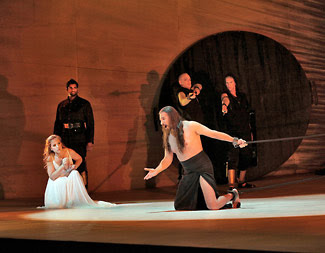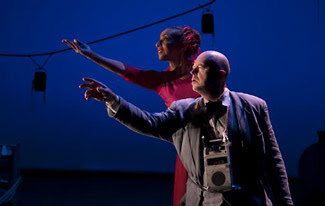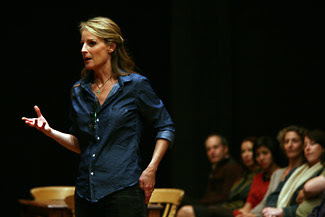
LBO’s artistic director Andreas Mitisek puts quite a bit into the show. The action is grafted onto Argentina during the late 70s and early 80s, a time of domestic terror when the county’s military government used state-sponsored violence to suppress political dissidents and thousands of citizens literally disappeared from the streets. Maria becomes a idealistic woman who falls in love with a rebel, a composite character called Payador. They are married and happy until Payador is arrested for his protest activities. Maria engages in a search for her husband in a seedy underworld and eventually is sexually assaulted by the police and taken into custody where her downward spiral continues despite eventually coming into contact with her former husband. The El Duende character in this version becomes an older version of Payador remembering the life of his lost love in a series of flashbacks.
It’s a bold take on the work and Mitisek and his players have put together something that looks incredibly good. The entire performance is given behind a scrim over which black and white images of stock footage from the period is projected alongside imagined scenes between the principal characters. There’s also a wall of faces of the “disappeared” that slowly rains down in random segments over the performances opening music. The cast itself, all amplified throughout, sounded great. LBO favorite Peabody Southwell sang Maria with clarity and real energy in a very physically demanding staging where she is often dancing or in physical conflicts with others. Her young lover was the equally enjoyable Gregorio Gonzalez who handled the show’s only other singing role in this version. The spoken part of El Duende went to Gregorio Luke who was commanding even with the evocative poetic lines he was given that rarely related to the action on stage. The members of the Nannette Brodie Dance Theater were always present providing the dance material that is commonly found in staged versions of Piazzolla’s score.
But despite how good this looked and sounded, and as much as I admired Mitisek and company’s bold adaptation, I found the whole thing rather wanting. Mitisek claims in his program notes that he “wanted to go deeply into the soul of this work and give it a contemporary meaning beyond clichés and stereotypes.” But I’m not sure that whitewashing the more unseemly aspects of Maria’s character to make her a revolutionary lover and symbol for all the good aspects of a nation’s spirit is necessarily avant-grade. Mitisek continues, “Maria is the ultimate metaphor for the heart and soul of Argentina and also a symbol for love, hope, fear, and resilience.” Fair enough. But none of that makes her necessarily very interesting or human as a character. Instead the complexity of the woman, and if taken symbolically the country she represents, is watered down to a sort of populist propaganda with a veneer of exotic sexuality tossed in for good measure. Long Beach Opera’s Maria de Buenos Aires is certainly attractive and professionally done, but it doesn’t quite deliver on the radicalism implicitly promised by its own premise. There's another performance on Saturday February 4th at The Warner Grand Theater in San Pedro.
























